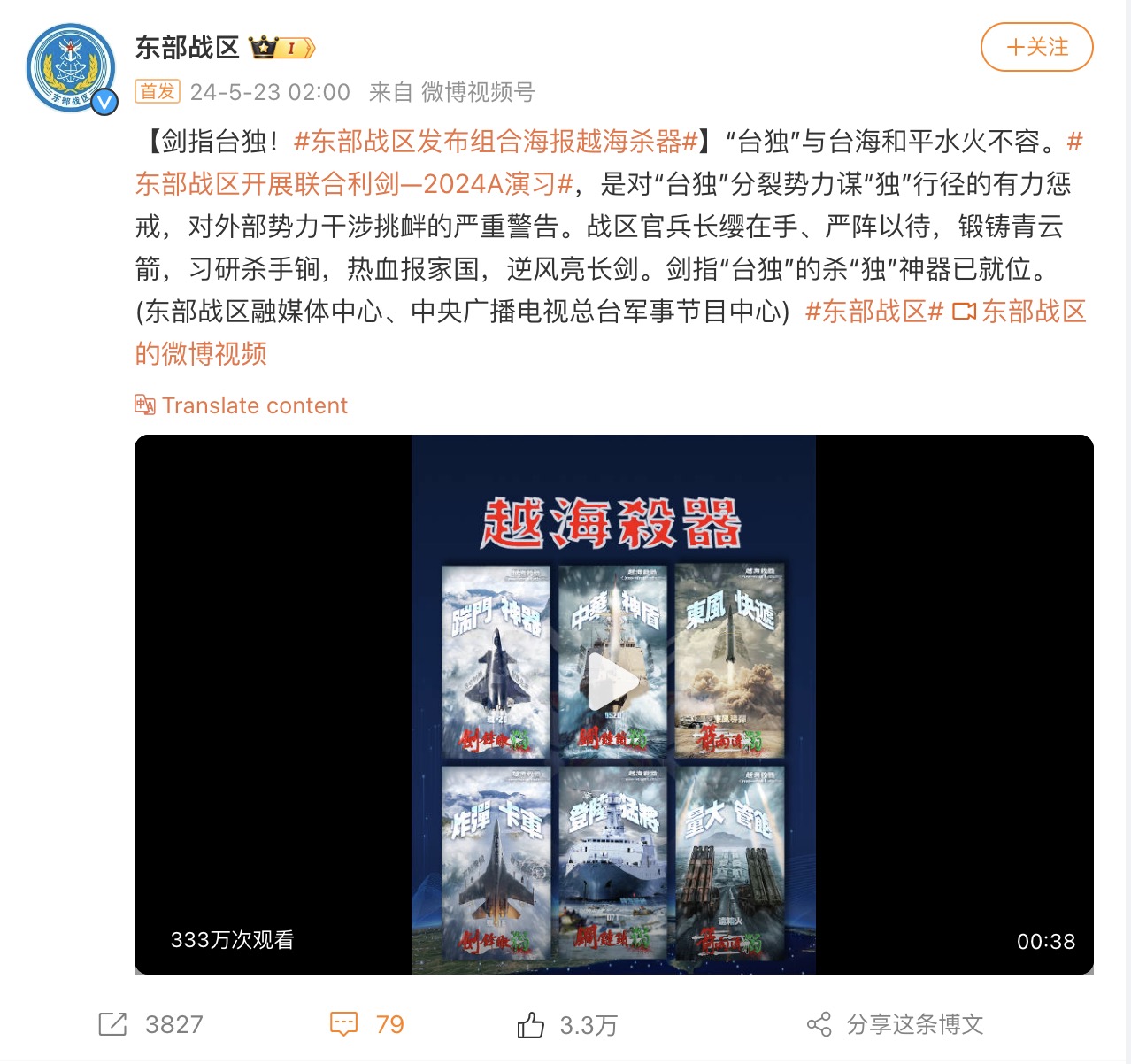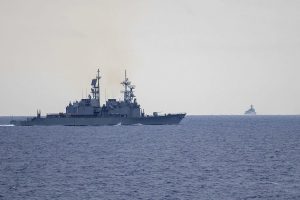Shortly after the inauguration of Taiwan’s President La Ching-te on May 20, China initiated an unannounced two-day military drill around Taiwan. Accompanied by well-coordinated influence operations on major social media platforms, China is attempting to steer public opinion into its favored direction by framing the People’s Liberation Army’s provocative actions as a “punishment” against Taiwan’s “separatist act” while actively contesting Taipei’s ability to exercise its sovereignty, jurisdictional, and law enforcement rights at a near-threshold of military confrontation.
In essence, Beijing’s disinformation and influence operation intertwined with gray zone tactics, as well as legal, and cognitive warfare – under its hybrid warfare strategy – seek to challenge the current status quo in the Taiwan Strait and actively redefine what constitutes unacceptable behaviors in the 21st century international rules-based order. The world needs clearer guidelines on defining the threshold of Beijing’s coercive activities to foster effective cross-domain deterrence and collective responses to counter China’s hybrid warfare.
The Eastern Theater Command of the People’s Liberation Army (PLA) framed its provocative actions as a “serious warning” and “effective punishment” for Lai’s speech, which was labeled as a “separatist act” of “Taiwan independence” forces. Beijing leveraged state and state-affiliated entities and their sock puppet accounts to amplify this narrative on both Chinese and Western social media platforms such as WeChat, Weibo, TikTok, Facebook, and X (formerly Twitter).
For instance, on May 22, Eastern Theater Command published a Weibo video titled “Sword aiming at Taiwan Independence!” with a hashtag “#Eastern Theater Command Releases Composite Poster of Across-Sea Killing Tools#” (剑指台独!#东部战区发布组合海报越海杀器#). The video boasted the PLA’s military capabilities and described their weapons as “Across-Sea Killing Tools.”
What’s most interesting about the post is that it used traditional Chinese characters (the written language used in Taiwan) for the video’s subtitles and the poster’s words, while using simplified characters (the written language for mainland Chinese) for the post itself. That makes clear that the target audience is Taiwanese – but the use of simplified characters for the social media post lets the video blend in more inconspicuously when amplified by China’s state media’s socket puppet accounts on Western social media platforms.

A screenshot of the Weibo post and video from the PLA’s Eastern Theater Command. Note the use of traditional characters in the video itself.
Today Strait (今日海峡) and Straits Plus (台海時刻), for example, have both posted the same video on Facebook and TikTok, respectively, which has a more active Taiwanese user base than Weibo. Today Strait is a Facebook page managed by Fujian Straits Satellite TV (福建海峡电视台) while Straits Plus is a TikTok account managed by the Fujian Provincial Radio and Television Bureau (福建省广播电视局), which is under the direct control of the Fujian provincial government.
It is also noteworthy that both accounts have no labels (Facebook and TikTok have labelling features for state-controlled media) nor information in the bio section indicating their state affiliation. The lack of a clear label could mislead audiences by creating an illusion that these are independent media outlets when in reality these social media handles repeatedly amplified China’s narratives – including the claim of “Taiwan being part of China.” These and other Chinese state-controlled social media channels thus strengthen the legitimacy and public support of Beijing’s provocative actions.
Moreover, after the PLA’s military drills began, the exercise was used as “evidence” to accompany and reinforce Beijing’s claim to Taiwan. At the time of this analysis, 49 PLA aircraft, 19 PLA Navy vessels, and seven China Coast Guard vessels were detected operating around the island. Of the 49 aircraft, 35 had crossed the median line of the Taiwan Strait, according to Taiwan’s Ministry of National Defense. Added to China’s “new normal” of intrusions since 2022, the latest drill solidifies Beijing’s denial of Taiwan’s sovereignty and jurisdiction.
China’s state media utilized relevant video footage released by officials for their operations on social media to further amplify the news and Beijing’s assertiveness. For instance, China’s top news broadcast, “Xinwen Lianbo” – a production of state-broadcaster China Central Television (CCTV) – featured the military exercise “Joint Sword – 2024A” conducted by the PLA’s Eastern Theatre Command. Scenes included fighter jets in flight and PLA soldiers warning Taiwanese vessels that “the waters are under Chinese jurisdiction” and that Taiwan has “no right to interfere.”
While such videos are usually first published on Chinese social media platforms such as Weibo and WeChat, this propaganda quickly spread to Western social media as illustrated above – portraying an impression that PLA’s provocative gray zone tactics are both justified and threatening. Beijing’s likely goal is to generate fear and anxiety among the Taiwanese and thus erode support for the new Lai administration.
In a nutshell, Beijing is carrying out hybrid warfare strategies – influence operations, military actions, gray zone tactics, legal and cognitive warfare – against Taiwan. These tactics are cohesively deployed in multiple domains that mutually reinforce each other to optimize impact. As the integration of such tactics exploits the gray zones in existing international norms, it poses great security challenges to G-7 countries and beyond.
Undeniably, Beijing now possesses greater national capabilities compared to 1995-96, when the last Taiwan Strait crisis happened. Yet those capabilities also come with a price – for instance, greater interdependency, especially in the global supply chain and financial market. This makes Beijing vulnerable – and able to be deterred, so long as deterrence is tailored to address these challenges.
Given that warfare in the 21st century exists across multiple domains including space, economic, cyber, and information spheres, like-minded democracies must establish a comprehensive deterrent strategy that extends beyond traditional security issues and addresses the intertwined nature of hybrid warfare – cross-domain deterrence – to secure peace and stability in the Taiwan Strait.
Despite the current lack of consensus among like-minded countries on Taiwan-related policies, G-7 countries had previously showcased the possibility and willingness to coordinate response packages when necessary, such as in the case of collective sanctions against Russia for its war on Ukraine.
These precedents paved the way for like-minded democracies to generate a potentially more unified and comprehensive approach in terms of economic and diplomatic actions against authoritarianism. Yet as Beijing is challenging international norms and the rules-based order below the threshold of kinetic warfare, China has been exploiting a significant gap in deterrence.
Therefore, a transparent and universal framework that conceptualizes and operationalizes deterrence in multiple domains is imperative for countering Beijing’s hybrid warfare. The latest PLA military drills are merely the tip of the iceberg. Beijing is constantly creating dangerous “new normals” that suit its political and strategic agendas. Look at the China Coast Guard’s gray zone activities in the East and South China Sea against Taiwan, Japan, the Philippines, and beyond. Will we need real casualties before crafting an effective deterrence strategy and response package?
Like-minded democracies need clearer definitions and agreement on what constitutes unacceptable behaviors – a cross-domain deterrence framework that unifies the threshold of coercive and hostile actions for hybrid threat analysis and thus fosters collective responses against Beijing’s aggression.

































